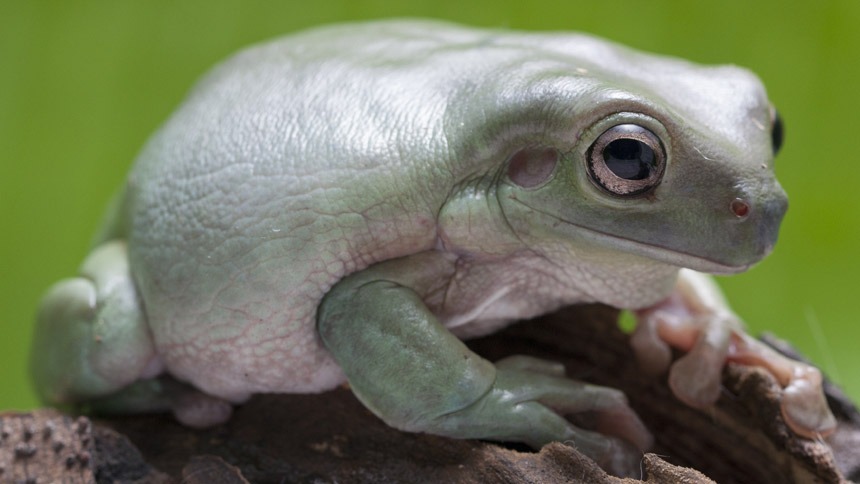
White’s Tree Frog Care Sheet & Pet Guide
Also known as Dumpy Frog or Australian Green Tree Frog (Ranoidea caerulea)
Also known as “Australian Green Tree Frog” or “Dumpy Tree Frog“, this is one of the largest, most popular tree frogs kept as pets among hobbyists. They come in different morphs and they’re one of the few amphibians that occasionally tolerate handling.
It may surprise you to learn that caring for a White’s Tree Frog isn’t too difficult. With the right guidance, you’ll be confident in keeping one yourself. So, let’s get started.
Page Contents
How To Care for a White’s Tree Frog
Caring for a white’s tree frogs is fairly simple once you’ve learned the basics. Setting up their habitat is important but once finished, the rest is easy.
One of the reasons for their popularity is their size. They’re bigger than your average tree frog. Adult White’s Tree Frogs grow up to 4.5 inches in length. Not only are they long, but they’re also heavy.
The other reason they’re so popular is that they tolerate handling more than most other amphibians. This doesn’t mean you should hold them all the time but the occasional handling is fine!
Their size and weight need to be taken into consideration when setting up their habitat. Small plants will likely be crushed and housing more than one together requires a large enclosure.
Habitat Setup
Dumpy tree frogs need a well-thought-out habitat setup. While it’s true they’re one of the easiest species to keep as pets, you need to put careful consideration into their habitat setup.
Below is a list of the recommended items to get before purchasing your first dumpy. I’ll go over each of them in more detail in the sections below.
- Terrarium / Enclosure – Due to the sheer size of the frog, you should aim for a 18″ L x 18″ W x 24″ H vertical-style terrarium if you’re housing 2 – 3 dumpies. Find the ideal tree frog terrarium here. You can go as small as a 12″ L x 12″ W x 18″ H for 1 – 2 dumpies but that doesn’t leave them much room to move around.
- Substrate – A nice ABG mix is recommended for bioactive vivarium setups. It will provide all the nutrients for live plants and support a population of springtails and isopods. If you’re going with fake plants you can use a simple coco-husk substrate.
- Drainage Layer (optional) – A drainage layer is required if you plan to do a waterfall feature. A white’s tree frog needs a humid environment but nothing that requires you to set up a drainage layer.
- Plants, branches, and decorations – Branches are a must for any tree frog enclosure. The goal is to provide your pet with many opportunities for both climbing and hiding. Plants and decorations are utilized as hiding places for your frogs.
- Lights – UVB isn’t required but it won’t hurt tree frogs in low doses. The most important aspect of lighting is to give your pet a day/night cycle. 12 hours of day/light and 12 hours of night/dark is recommended. Consider an LED grow light or small T5 for live plants. Just be sure they’re not overheating the cage!
- Misting or Fogging System (optional) – A full-blown misting system or fogging system would only serve as a convenience to you (they’re mostly automated). You need to mist the enclosure daily to ensure humidity is within the recommended range but this can be accomplished with a cheap spray bottle or mister bottle.
- Heating – A heat lamp is required to keep a temperature gradient within the enclosure. Be sure to read the temperature section for more information. A thermostat is recommended to help regulate the temperature and prevent overheating.
- Thermometer / Hygrometer – You need a thermo/hygrometer in order to keep track of the temperature and humidity within the enclosure. It’s a requirement for proper husbandry but they’re cheap and easy to use. I recommend one near the top and one at the bottom.
- Water Dish – Arboreal frogs are rarely good swimmers but a water dish is still required. It doesn’t need to be gigantic but it should adequately provide the number of frogs you have with water.
Terrarium
Australian green tree frogs require more space than most other arboreal species due to their overall size. Still, one can get by with a minimum of a 12″ L x 12″ W x 18″ H for a single frog.
Having said that, most people want two or three frogs per enclosure. For this, you will need a bigger terrarium.
- 24x18x18 vertical terrarium (recommended) – 12″ L x 12″ W x 18″ minimum
To put things simply, you can do 1 – 2 dumpies in a small vertical terrarium or 2 – 3 in a large vertical terrarium. Many hobbyists put up 4 of them in a single 18″ L x 18″ W x 24″ H Exo Terra (or equivalent brand/size) and they seem to do well.
Substrate
The type of substrate you should use largely depends on what type of setup you’re going for. A naturalistic setup with fake plants and branches could use coco-husk fiber substrate like eco-earth.
Bioactive vivariums with live plants, springtails, and isopods would benefit from a substrate like ABG mix. This will provide everything the plants need to grow and thrive.
One benefit substrate has in frog husbandry is that it retains water and helps regulate the humidity. Certain types of substrate (like coco-husk fiber) retain water really well. This is great if you’re trying to raise the humidity within the enclosure. Different kinds of substrates are good at letting water drain.
Temperature
White’s tree frogs prefer warm temperatures but they also enjoy a range from warm to cool. They need a heat source (a heat lamp, for example) for their setup because their recommended temperature range is higher than the ambient temperature in most people’s homes.
- Temperatures between 85 – 75 °F during the day & low 70’s – high 60’s at night.
It’s best to provide a temperature gradient within the enclosure. This means you have higher temps at the top of the enclosure and lower temps at the bottom.
A small heat lamp should provide all the heating you’ll need. Always pair your heating device with a thermostat to prevent overheating. A thermostat is meant to shut off a device if it malfunctions and overheats.
Anyway, shoot for a temperature around 85 degrees Fahrenheit towards the top of the enclosure and 75 degrees towards the bottom. Having this gradient will allow your dumpy a range of temperatures to choose from. Accompany this with plenty of branches and leaves for hiding and he/she will be happy.
Humidity
Having the correct humidity is essential for proper care of any amphibian. This species likes the average humidity to be around 50% with occasional spikes around 70% – 80%.
- Maintain humidity around 50% with occasional spikes around 70 – 80%
Achieving this is as simple as misting the enclosure twice a day. Be sure to get a quality thermometer/hygrometer so you can tell what the humidity is after each misting.
You definitely don’t have to set up an automatic misting system (like MistKing) or fogger but you can if you really want to. So long as the humidity stays within the recommended levels.
Ventilation is needed to keep the air circulating. Terrariums from Exo Terra, Zilla, and Zoo Med are great for this as they have screen lids and vents near the front latch.
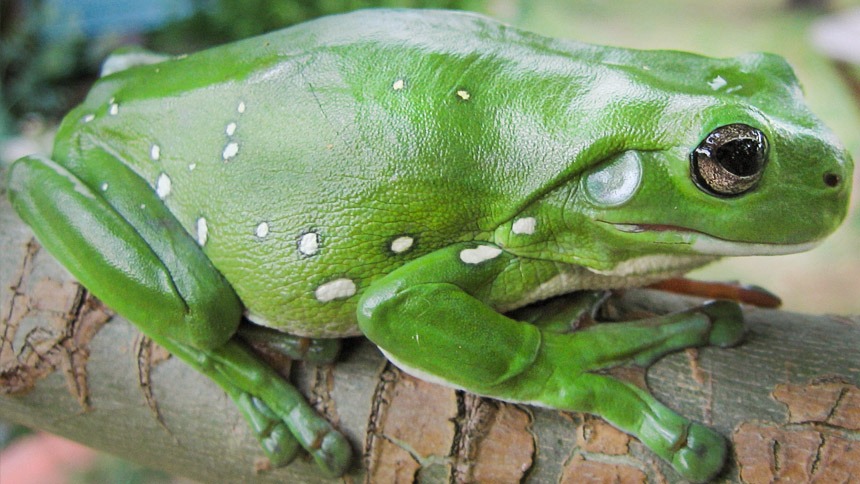
Lighting
The main purpose of a lighting fixture for your white’s tree frog is to provide them with a day and night cycle. Basements or dark rooms are good places to keep your pet amphibian but you need to remedy this by providing lights for the day time.
After all, you can’t let your dumpy sit in the dark all the time. They need to know when it’s day time and when it’s night time.
- Recommended 12 hours of light and 12 hours of dark
Another reason lighting is important is when you have live plants in the enclosure. Real, living plants require light and many of them won’t grow without special “grow lights”.
Grow lights come in many different shapes and forms but two of the most popular kinds are LEDs and T5 grow lights. Since this is a care guide for white’s tree frogs I won’t go into detail about lighting. Just know that you may need special lighting to provide everything your live plants need to grow.
Water Quality
The quality of water you give your white’s tree frog is important. All amphibians need clean, dechlorinated water. Tap water is the easiest source of water for most hobbyists to obtain but it’s often the worst choice.
- Use clean, dechlorinated water in a shallow water dish
Tap water is the stuff most of us get out of the kitchen faucet. It comes directly from the municipal water treatment plant where raw water is cleaned and treated with chemicals like chlorine and chloramines. They’re necessary to kill harmful bacteria in the water and they’re considered fairly safe for human consumption.
Those chemicals are irritating and harmful for amphibians, who readily absorb water and all the chemicals in the water, through their skin. It affects them differently than us. For this reason, you need to treat tap water with a water dechlorination agent or use bottled spring water or RO (reverse osmosis) water.
Treating chlorinated tap water is as easy as putting a few drops of a dechlorination agent in it. ReptiSafe water conditioner is a product I’ve used and recommend, but similar products will work just as well.
Once you’ve got clean water you’ll need somewhere to put it. A medium-sized, shallow water dish is great for adult white’s tree frog.
I like to use a water dish at least twice the size of the frog. Also, take into account the number of inhabitants in the enclosure. A bigger water dish may be required for an enclosure with 3 or 4 white’s tree frogs. Last but not least, make sure the water dish isn’t too deep!
Plants, Branches and Decorations
The proper care of a dumpy frogs starts with safety in the enclosure. Decorating its habitat might seem trivial but consider the size and weight of this tree frog.
Logs and branches need to be sturdy and placed in such a way that they won’t fall over or crush your frog.
Plants, whether live or fake, need to be placed carefully as well. Choose strong, sturdy plants and place them strategically so they won’t get pulled out of the ground or crushed by the weight of your frog!
Again, when using real plants you need the proper substrate and lighting.
White’s Tree Frog Diet

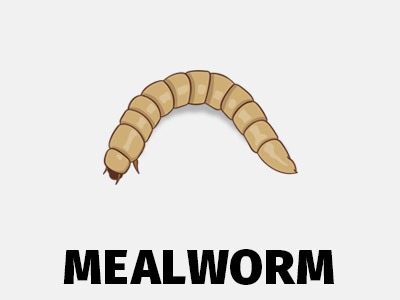

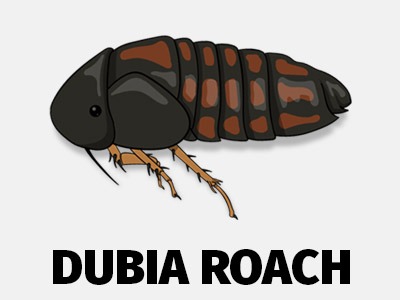
In captivity, white’s tree frogs eat mostly appropriately-sized crickets although dubia roaches, horned worms, and wax worms can be used as well.
- Crickets (dusted with vitamins/mineral)
- Dubia Roaches
- Waxworms and Horned Worms
It’s important to dust your dumpy’s feeder insects with vitamins/minerals and calcium. This is required to maintain a healthy diet in captivity. What frogs eat in captivity isn’t enough to keep them healthy, hence the reason for supplements.
They have far more options and variety in the wild than they do in captivity. This is where they get all the vitamins and minerals they need. This variety isn’t available in captivity. We’re limited to what we can buy at the pet store or rear at home.
So, now that you know what to feed your pet white’s tree frog, let’s determine how much and how often to feed him. Most hobbyists feed their dumpy’s 3 to 4 times per week. This is a good start.
The amount of feeder insects you give them depends on their size and age. A good starting point is 2 – 3 insects (crickets, for example) per feeding. If your frogs eat all the insects, you need to increase the number by 1 the next time you feed them.
When feeding your new dumpy, start with 2 – 3 appropriately-sized crickets every other day. If all the crickets are eaten within an hour of feeding, give them 3 – 4 crickets the next time you feed them.
Repeat this process until you’ve found the right amount to feed them. Just know that overeating is a common problem for this species. Proper care includes ensuring your pet isn’t overweight. Feeding them fewer crickets per feeding session is fine when the frog is overweight.
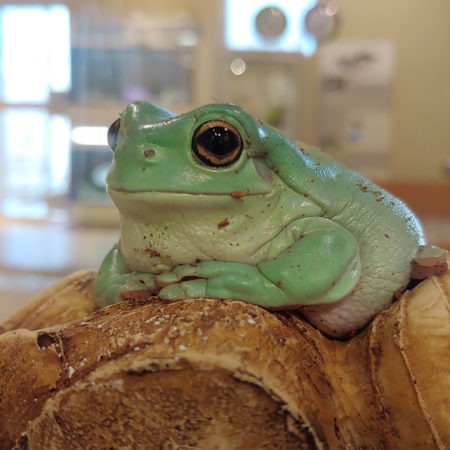
As always, dust their crickets or other feeder insects with reptile vitamins/minerals and calcium to ensure they’re getting all their nutritional needs.
Fun fact: Australian green tree frogs are thought to sequester mild toxins as a result of consuming certain insects in the wild. Don’t worry, they’re still safe to handle. Just be sure to wash your hands afterward.
Reproduction
Breeding white’s tree frogs and raising tadpoles to froglets and eventually, juvenile frogs is a rewarding experience. Doing this requires careful attention to the habitat and, of course, at least one male and one female.
Sexing
The first step is fairly obvious; ensure you have both male and female Australian green tree frogs. Determining this is pretty straight forward, especially if you have several frogs to compare.
Females are larger, growing up to 4.5 inches in length while males are smaller.
Another way to distinguish males from females is by their nuptial pads. Males have nuptial pads that are found on what is considered the thumb of their front limbs. Look on the inside of the thumb for a dark spot and/or bump.
Once you’ve determined you have both male and female, it’s time for the next step.
Breeding
In order to get most white’s tree frogs to breed, you need to place them in a rain chamber. A rain chamber is a special setup that mimics rainfall. Hobbyists build them with water pumps and PVC pipes to circulate water from the bottom of the tank to the top. Once at the top, the water drips down at a rate similar to rain.
Why is this important? Well, it’s meant to simulate breeding season. During this time of year, the temperature is higher and its raining. In addition to this, food is more plentiful so feeding them a bit extra may prove helpful.
Two or three months of lower humidity and less water accompanied by lower temperatures and less food is a good way to mimic winter months. Once the winter months are over, do your best to mimic the rainy season. Increase the temperature, put them into a rain chamber, and feed them more food.
It also helps to have competition between the males. Having 3 or 4 males per female is a good ratio.
With any luck, you’ll start seeing eggs in the enclosure within a few days.
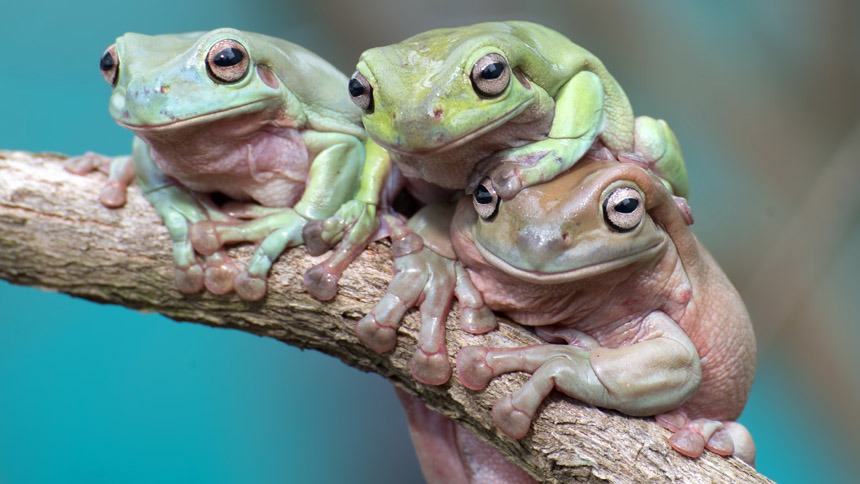
Tadpoles
Eggs and hatched tadpoles need to be moved into a separate container as the adult frogs might eat them. Be mindful when transferring them; they need time to acclimate to the water in the new enclosure.
Water Temperature & Quality
Before transferring, make sure the water they’re going into is between 82 – 85 °F. The water should remain at that temperature throughout the duration.
Also, the quality of water is very important. It needs to stay clean and should not contain chlorine or chloramines from tap water. Use a water conditioner or better yet, use RO (reverse osmosis) or bottled spring water.
Once you’ve prepared your water its time to transfer the tadpoles. Placing them in a bag filled with water from the rain chamber and placing that bag inside the water in their new tank is preferred. This will give them time to acclimate.
Feeding the Tadpoles
At this point, you’ll want to start feeding the tadpoles 2 to 3 times per day. Each feeding should allow the tadpoles 45 – 60 mins to eat before removing the leftovers. This will help keep the water from getting polluted.
There’s a variety of things you can feed them but many owners like frozen worms, boiled lettuce, commercial tadpole food, or hard-boiled eggs.
I’ve personally had the most success with a combination of boiled spinach leaves and commercial tadpole pellets. The tadpoles would primarily eat the boiled spinach leaves but occasionally I could see them eating the pellets, which are high in protein.
White’s Tree Froglets
As the tadpoles metamorphose into tailless, baby frogs you should provide them with a climbing surface. Once their tail has been absorbed they are ready to move into a terrarium.
Froglets can be fed appropriately-sized feeder insects at this point. Pinhead crickets or wingless fruit flies should be small enough to provide a healthy meal for a small white’s tree frog.
For a much more in-depth guide on this topic, check out the Australian Society of Zoo Keeping’s husbandry guide.
Handling Your White’s Tree Frog
White’s tree frogs are one of the few species of amphibians that tolerate handling. Some owners still prefer not to hold them but 10 – 15 minutes once or twice a week is alright.
Be sure that your hands are clean and you’re practicing proper handling etiquette. Do your best to keep them from jumping out of your hands, falling to the ground, and getting hurt.
I hope this care guide has been helpful to you! If you have any questions, feel free to use the commenting system below.
Dumpy Tree Frogs In the Wild
White’s tree frogs are found primarily in Australia. They inhabit nearly half the country on the North, North-Eastern side. In addition to this, white’s tree frogs are found in Papua New Guinea and Indonesia.
These large tree frogs inhabit mostly tropical rainforests but can often be found near bodies of water in low-lying grasslands and swamps. Being a true arboreal creature, you’ll find them in the canopy of trees in whatever location they’re dwelling in.
This species was first described by John White, hence their common name “White’s Tree Frog”. In Australia, they’re simply referred to as green tree frogs.
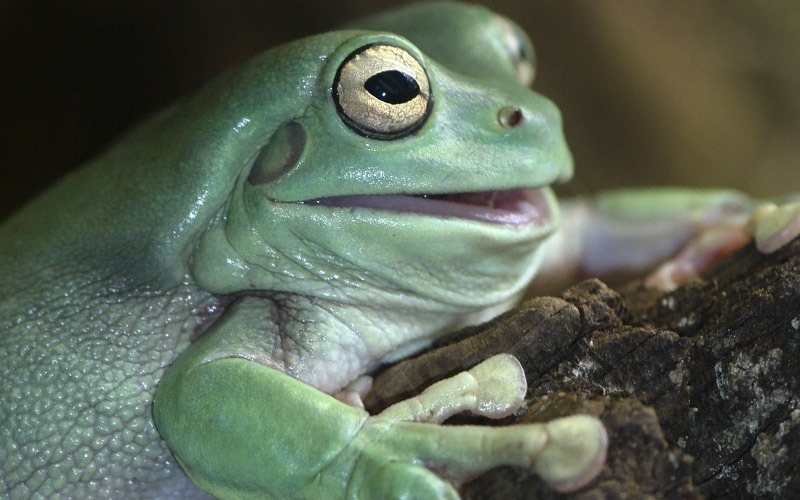
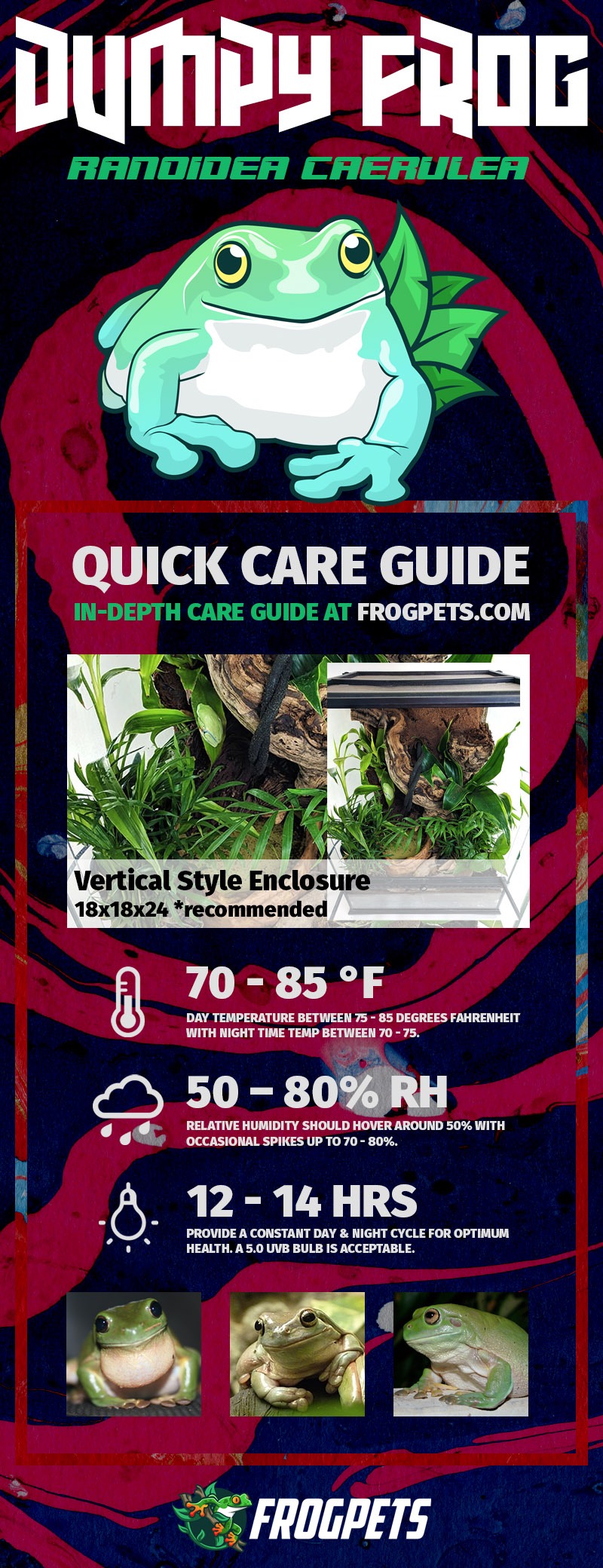

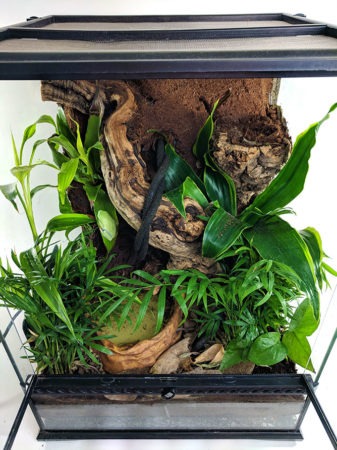
65 Comments
Hi John, I was wondering what animals besides Millipedes and Crested Geckos can I place in the paludarium with the dumpy?
Cheers!
Hi, I am thinking of getting some white’s tree frogs, and I was wondering, what size enclousure would be ideal for three of them? And would frog foam be good for them as well? Thanks.
A 18x18x24 terrarium should work.
Is it okay to use reptisoil and sphagnum moss in my white’s tree frogs enclosure?
Both of them are perfectly fine for a white’s tree frog enclosure.
no moss may ingest thus impaction, they eat anything.
Hello, I’m looking into getting a White’s Tree Frog and I have a few questions. Would this type of frog be okay in a paludarium with fish? If I did have one in a paludarium would I need to give them a shallow water dish in addition to the other water? How much ground space would they need? Thanks so much! Your article was really helpful.
I’m glad it helped! You don’t need an additional water bowl and a White’s Tree Frog would be perfectly fine with small fish! I’ve seen hobbyists do paludarium setups with a full water bottom and floating cork bark pieces. The thing to consider is that you’ll need a good place for your crickets to go when you feed your frog(s)! Some of them will likely drown in the water but you’ll want to minimize that as much as possible. I hope this helps!
What kind of isopod can i put in with them ?
Any of the tropical species. You could do dwarf whites or purposes, or zebras!
Hi I found this article very helpful. I am looking into getting frogs and I live in canada so if it is 30 degrees outside in the summer is it necessary to have a heat lamp during the summer? Also do you know the approximate first time cost for frogs?(If so what are the ongoing costs). And can you hold a frog longer/more often if you have gloves on?
Your article was a big help Thank you so much!!
Thanks for your nice comment, Hannah. I always recommend keeping pet frogs inside, in a terrarium/enclosure. You’ll likely need a heat lamp unless the temperature inside your house is within the recommended range for Dumpies. As for the cost – that depends on how you do your setup. The enclosure alone will cost around $100 US. Larger terrariums are more expensive, ofc. For all the supplies, tank, and White’s Tree Frog, you may find yourself spending $200 – $300. The upkeep isn’t much; you need feeder insects. Crickets, for example. Every pet store is different but I would encourage you to call around and see how much 25 – 50 crickets cost. Gloves are helpful when handling frogs but so long as your hands are clean and damp, you’ll be fine. The length of time in which you can/should handle a dumpy depends on the frog itself but the less you hold them, the better.
Hi, John! I recently got a dumpy tree frog. I set up her terrarium, and I’ve been able to keep the temperature and humidity at the right level. My main concern right now is that she’s very inactive and I haven’t been able to get her to eat yet (because she’s been sleeping). The place I got her from fed her yesterday, but how long before I should be worried?
Hey, Katelyn! Your dumpy will likely eat during the night-time hours. Give him/her a few days and see what happens. Try feeding 2 – 3 crickets before dark and see if the crickets are still there in the morning.
Hey John,
We have 18 x 18 x 24 tank. Blue heat light 60w and USB bulb. Will we need a heat pad for night when we turn off lights? It gets below 60° sometimes at night. If we do need a heat pad, which one do you recommend? Thanknyou so much.
That’s a little on the cool side! Try and keep it in the upper 60s if possible!
I’m getting my first tree frog soon. Is humidity and temperature a hard thing to maintain in a 10 gallon tank lined with A mossy liner on the bottom. And how moist should the tank be?
It depends on where the humidity needs to stay. For Dumpy tree frogs, 70% – 80% is recommended and it won’t be hard to maintain this if part of the lid is covered. Moss retains a lot of water. This will help retain some humidity. Since a 10 gallon tank is small, humidity and heat will be fairly easy to keep up with. I would, however, recommend a bigger tank than a 10-gallon for a dumpy. They get pretty big for tree frogs.
I have a 7 month old whites tree frog. Recently he has been sleeping in one corner all the time. He has never done this before. I know he is up at night but I haven’t seen him up the past few nights. In the morning his water bowl is empty. I held him yesterday and he seemed fine. I feed him 3 to 4 meal worms a day. He has a bottom heater and a heat lamp on top. He also has a light. I just wanted to make sure my little guy was ok.
My initial thought is maybe he is in that corner because the temperature and/or humidity is most suitable to his liking. Have their been in changes in his enclosure? Is the temperature and humidity within the recommended range?
Hey, I am thinking about getting two Medium Australian Whites Tree Frogs from LLL Reptiles and I saw at Josh’s Frogs there is a foam type of thing that you can put in the terrarium to hold water or something like that and you can add stuff on top or just keep that foam. Do you think it would work? I was thinking of putting moss or some substrate on top but what would you think would be best for the frogs.
I think you’re talking about the foam liner product? It should work fine but I don’t believe its meant to have a loose substrate (like coco husk fiber) on it. Moss would be fine because you can easily move the moss from the foam liner in order to clean it. I’ve never used it and don’t know exactly what it’s meant for but my guess is its a good material to hold water which is easy to clean.
Hi! This is a really informative article and quite easy to understand. I have a question, however, how many watts would you recommend for the heat lamp? (to be used in a 18x18x24) Thanks!
Hi John! Great article, I got a dumpy tree frog two weeks ago and I have only been able to confirm two frog poops since arriving (there was poop in the container the frog arrived in so technically three). We have a layer of sphagnum moss over coconut husk fiber so it would be easier to spot poop to spot clean but either it’s blending in or the frog has only pooped twice in the water bowl since moving into the vivarium almost two weeks ago. What is the frequency of healthy bowl movements for these frogs? How likely is is that I am over looking poop on the substrate, would it have time to dry out overnight with humidity higher than at least 40%? Thank you!
Hey there! My guess is that you’re just not seeing it in the substrate. Another tip would be to look for droppings on leaves and branches. Almost all the droppings I’ve found in my tree frog enclosures has been on a branch, leaf, or on the side of the terrarium (on the glass). The droppings are small and certainly blend in with the substrate. Don’t forget that tree frogs are all over the enclosure; on the back sides of branches and vines, under leaves, etc. So the droppings could be anywhere.
Is your dumpy eating regularly?
Hello! I might possibly be getting a dumpy soon(great name btw lol) and I just had some questions since this would be my first frog. I know these frogs are nocturnal, but are they loud at night? Also, in the summer here it gets pretty hot and I like to use an air conditioner, will it has any effect on the frog if its using a heat lamp? Okay last question, does this frog require a light for it, or will it be okay with just window and regular lamp light? Sorry for all the questions haha, thanks a lot 🙂
Hey there, Rye! so long as the temperature in their enclosure is within the recommended range, your dumpy will be fine! Yes, dumpy’s are super loud! lol. Compared to most frogs, at least. They do need a dependable day/night cycle. This means you’ll want to provide them with light during the day and make sure they have dark hours as well (for the night).
hey john, if i were to go on vacation for 2 weeks, would my juvenile dumpy be okay without food for that long? if i kept some frozen dried mealworms or crickets in a bowl??
That’s hard to say. I personally wouldn’t recommend it. An adult might make it that long but a juvenile is growing and needs food more often. Do you have a friend that could swing by and feed him/her a couple times?
Hi John, thank you so much for this article! I was wondering if whites tree frogs are happier in pairs or prefer to live on their own, or if it makes a difference to their wellbeing at all. Thanks!
It’s really hard to tell whether or not it makes a difference in the well-being. They do great individually and by in pairs! Some people keep 3 or 4 together.
John, thank you so much for all this amazing information. My son would like a dumpy and my partner and I are huge plant enthusiasts so our first thoughts were what can we grow in his terrarium?! If we got the frog a lovely big enclosure filled with live plants what would be the best plants and is there any we should really avoid??
Hey Niki! Great question! You’re in luck. This sounds like a match made in heaven! You would love setting up a bioactive terrarium I bet! Get some tropical plants and your son’s dumpy will love it! You might consider getting springtails and isopods as a cleanup crew for the substrate!
Any type of plant that produces a harmful substance. I’m sorry I don’t have a list handy at the moment. Just do some quick google searches to make sure they’re not harmful to amphibians. Another thing to consider the strength of the plant! Dumpy’s get pretty heavy (for frogs) so the plants need to support their weight or at least be placed in such a way that the dumpy won’t be able to crush/break it.
Hi John! I might be getting a frog soon and I was wondering if it would be suitable for my frog to live in this cupboard with its tank on the table I have in there, (the cupboard is in my room) could I shut the door or would I have to keep it open? and could I make it sound proof so I can sleep?
-Hallie
My initial concerns are with lighting and air circulation. Also, I assume the tree frog will be inside a terrarium which is placed in the cupboard?
Hi there. I have a juvenile dumpy, he’s not quite 3 inches yet. I have searched so many websites about the size of crickets and how often and his many to feed him. Every website says something different and the pet stores all say something different. So far we have been feeding him everyday, about 10 small crickets. But I don’t want to over feed him. (The pet store told us to feed him 10-12, twice daily!) But most websites say every other day. At his size, what size crickets, how many and how often should we be feeding him? Thanks!
Hahaha! Oh, my! Alright. Pet stores are great. Especially locally owned pet stores. The big brand ones hire people that don’t always know how to care for Anura. That’s okay. I understand your confusion. Here is a post about what frogs eat that goes into more details about feeding them.
1. Feed your frog appropriately-sized crickets. Nothing bigger than the width of its mouth. As he/she gets bigger; so should the size of the crickets.
2. Every website and pet store will say something different on a variety of topics.
3. While your dumpy is a juvenile, he should eat more often compared to when he is a full grown adult.
4. Here is how to know you’re over feeding him; there are left over crickets in his enclosure after the initial feeding.
Does he eat all 10 crickets each day? If so, keep it up. If not, feed him the amount he generally eats. Make sure you’re dusting the crickets with vitamin/calcium supplements!
Hi John! This page has been really helpful so far so thanks a lot 🙂
I got a lil dumpy friend some days ago and I’ve repurposed a 12 gallon aquarium to house it (it has a plastic and glass cover but I might fabricate a mesh one). I’m worried about the temperature since it’s generally around the middle to high 60s during both day and night. I’m still arranging how to set up a UVB. Meanwhile, would it be harmful for the frog if I power an infrared lamp inside for 30-60 second periods during the day just to maintain temperature? Also, could the UVB hang inside the enclosure or is that dangerous? Finally and just to make sure, is the UVB light also a heat source or do I need to pair it with a heating lamp?
Thank you so much you’re great
I wish I could offer some advice on the infrared lamp. I need to read the latest studies. It’s a touchy topic in the reptile/amphibian industry. If you seek out information related to infrared, my recommendation is to read scientific studies and not listen to “pet gurus”.
Anyway, that temperature is too low for your white’s tree frog. Especially during the day. I know you’re working on fixing this! Great job 🙂 I recommend getting a ceramic heat lamp + a 5.0 UVB bulb. The UVB bulb won’t heat the enclosure and this is why you need a heat lamp. Keep the heat lamp above the enclosure and get a good thermometer/hygrometer to measure the temperature and humidity. Get two meters if possible. Putting one at the top of the enclosure and one at the bottom will allow you to see how well the temperature gradient is within the enclosure. Having a range in temperature from top to bottom is great btw! I hope this helps!
Hi, I just got my whites tree frog three days ago and I’m having trouble maintaining the humidity. Would having a layer of eco earth and some sphagnum moss be okay to use? The humidity gets down to 30% and I mist the enclose. It also has a water bowl in there too but the humidity is still low.
Having eco earth and sphagnum moss would help a lot. Substrate helps retain humidity, especially those two (coco husk fiber and moss). You might find this page helpful.
Hi John!
I’m looking to get a white tree frog and I live in Australia, the average temperature is 60-80ºF, so would a heat lamp be 100% necessary? thanks.
I’d say you’re probably good to go lol. So long as the temperature and humidity range are within the recommended range!
Hi! i’m looking into getting a whites tree frog! This was really helpful, thank you! I was wondering what brands/types of fake plants you recommend? And how many plants/logs and branches to put in the tank? Thank you!
Hello, Nina! Really you can use almost any brand you find in a pet store. There are vines, fake plants, branches, logs, etc. As far as how many you place in the tank, that depends on your preference. So long as there are plenty of climbing areas and hiding places you will be good.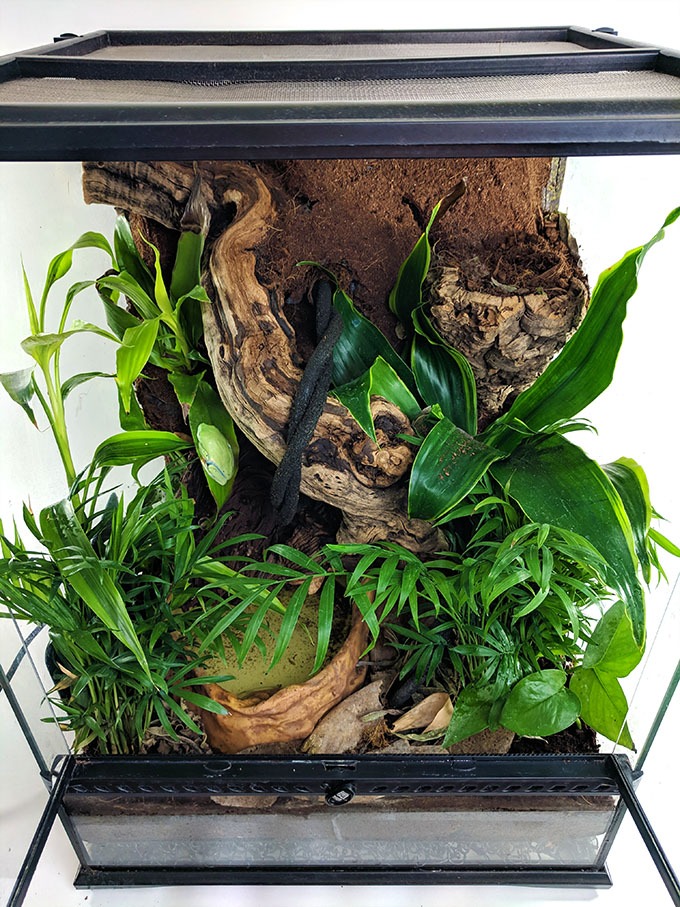
Just brought home our whites tree frog 2 NDA’s ago and he still hadn’t moved around in the vivarium. He is eating but not moving. Should I do something different?
Give him some time. Also, are you watching him at night? Because he will sleep during the day. Ensure the temperature and humidity are good.
Hi! I am planning on getting a white tree frog and I’ve never had a frog before. I switch houses every week and while my mom has agreed to taking care of my frog while I’m at my dad’s, I was wondering if they’d handle transportation well if I wanted to move it to my dad’s? Also your article has been very helpful and answered a lot of my questions.
Hey, Briana! I’m glad you found this page helpful. Transporting your frog once a week wouldn’t be a problem if you do it carefully. Is it possible to have a terrarium at your Mom’s and another terrarium at your Dad’s? The reason I ask is because a glass terrarium with substrate and decorations is heavy. It would be difficult to manage. You could get a critter-keeper for transporting your frog from one enclosure to the next.
Hey! I’m thinking about buying a couple white tree frogs and I was wondering, what kind of live plants I should get for their terrarium?
Good question! I should make a post about this sometime. You could do golden pathos (that’s a popular one), and bromeliads!
If you have a UVB light should you feed the frog the vitamin D3 as well, or just stick to the light? Also, will a UVB light provide the right amount of heating, or would I need to buy a separate heat lamp as well as the UVB?
Most UVB lights won’t put off enough heat by themselves. You’ll likely need a heat lamp too. The UVB/ Vitamin D3 is a good question. One I don’t have the answer to. Also, you’ll be hard pressed to find an accurate answer for this. I read a recent study about chameleons eating crickets. One chameleon was fed normal crickets; the other chameleon as given crickets dusted with calcium. Both had identical enclosures which included UVB bulbs. The chameleon who received crickets dusted with D3 ate few crickets than the other chameleon. This suggests the chameleon receiving normal crickets was trying to get more D3 in his/her system (hence the reason it ate more crickets). Well, that’s just one study about a reptile – not an amphibian. Even with the UVB bulb, I’ve continued using D3 myself.
Hello! Very helpful article.
I’m getting juvenile whites tree frogs in a few weeks (they will probably be 8-10 weeks old.)
How many crickets should I feed them a day? A few other sources say that I should feed them daily until they’re a bit older. Should I feed them one cricket each a day?
Thank you for the article!
-Althea
Hey Althea! This is a good question. I do my best to answer this question on this page about what frogs eat. You might read through that to see if it helps. The short answer is: it depends! Younger frogs should eat more frequently. Once every other day will work too. A few crickets each, every other day is what I recommend. Make sure to dust them with vitamin and calcium supplements (the crickets, I mean). Wingless fruit flies is another option for small frogs.
Hey, i’ve had my frog for three days and i have given it three crickets but she hasn’t eaten any. i even cover the tank with a towel at night thinking it was seeing people that stopped her from eating but still nothing.
Any update on this? Are the crickets small enough for your frog to eat?
what is a white frogs habitat and its diet
Please read this article! It’s a care guide and should answer all your questions.
May be a silly question! But interested in being a first time frog owner and I’m trying do all the best research! This guide was awesome! I am however wondering being nocturnal and all what of night averagely is it common to see activity from them? Is it earlier at night like 8pm or later ? Thank you!
Most frogs that are awake at night become active as the sun sets and light fades – regardless of time (assuming their day/night schedule is dependable). For example, leaving a light turned on above their cage will only cause problems with their sleep pattern. I hope that answers your question. Should you regularly feed your frogs right before lights out, you’ll most likely see them perk up shortly after the lights turn off.
Hey John Wellington! How are you doing? I hope that everything is great? I have a question if it’s not much to ask? I have two daughters that live in Arizona and they wants frog pet. They are beginners. They own a rabbit pet. No other pets at the house. Which frog do you recommend for them?
Hello, Alberto! I would definitely check out two guides on this website before picking a frog. Check the best & worst frogs for beginners and the beginner’s guide to keeping frogs as pets.
Hey John Wellington! How are you doing? I hope that everything is great? I have a question if it’s not much to ask? I have two daughters that live in Arizona and they wants frog pet. They are beginners. They own a rabbit pet. No other pets at the house. Which frog do you recommend for them?
Hey Alberto! I’m great! Thanks for asking. The South American red belly toad is a good one to start with. Pac-Man frogs are good and African Clawed Frogs aren’t bad either (they’re fully aquatic). I hope this was helpful! Let me know if you have any other questions!